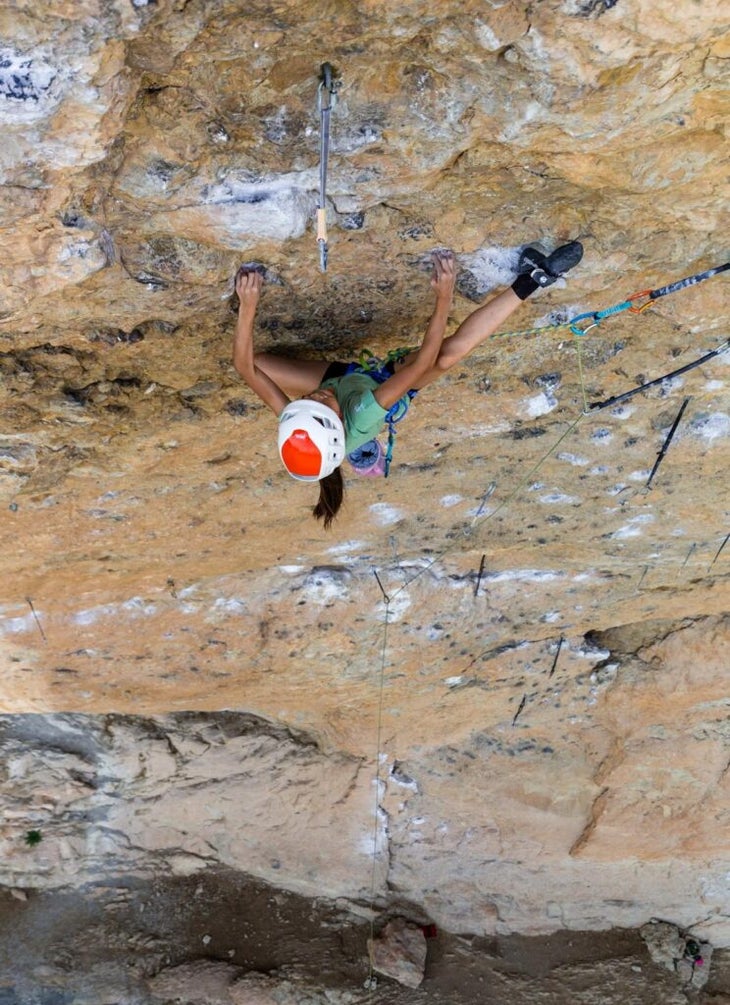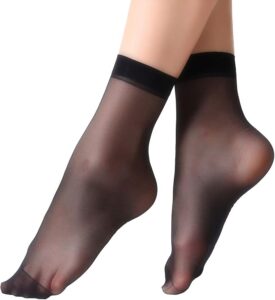Heading out the door? Read this article on the new Outside+ app available now on iOS devices for members! Download the app.
Earlier this month, nine-year-old Veronica Aimee Chik of Hong Kong became the youngest person in the world to send a 5.14b (8c) route—and she did it in socks. This did not go unnoticed by the climbing community.
We asked Veronica and her parents why she wore socks on Fish Eye (5.14b). And does she usually climb in socks? Her answer: always. “I feel good wearing silk socks with climbing shoes,” Veronica told me between routes at Red River Gorge (where she’s currently aiming to become the youngest person to send 5.14c). “It’s like my second layer of skin—very thin and also hygienic.” She elaborates that with socks on, her feet “never feel sticky and stinky.”

But Chik doesn’t wear just any socks. They are made of silk and as thin as a sock can get. Worn by male and female climbers alike, her pair of choice resembles pantyhose more than conventional socks. And she says all the kids are wearing them these days.
Climbing socks: Big in East Asia?
According to Veronica’s mom Vivian Wan, the socks she wears are popular in Hong Kong where the Chik-Wan family live, as well as across mainland China. Wan estimates that 80 to 90 percent of climbing gyms in China even offer complimentary silk socks to climbers.
What about other countries in Eastern Asia? Wan says she believes the trend of ultra-thin, pantyhose-esque climbing socks is primarily limited to mainland China. But in Japan, The North Face manufactures thin socks purpose-built for climbing. “Over the past decade, climbing socks have been recognized and adopted by a younger generation,” a spokesperson for The North Face Japan told Climbing. “Although there are still a good number of barefoot climbers, a lot of new climbers are starting with climbing socks.”
The socks that The North Face Japan manufactures employ an anti-slip split yarn throughout the sock to reduce slipping and enhance grip inside the shoe. Thin construction allows the climber to retain sensitivity with small or friction footholds. And a deodorized yarn helps reduce bacteria and odors.
The North Face Japan spokesperson also shared that they’ve seen a “steady upward trend” when it comes to climbers wearing socks with their shoes. To meet the needs of this growing sock-wearing consumer base, they will release a new pair of climbing socks with improved durability and comfort in fall 2026.
Why the Western bias against climbing socks?
Meanwhile, in the United States and Western countries, wearing socks with climbing shoes remains a heated debate. In a recent poll of Climbing’s Instagram audience, 75% of respondents said they have never climbed in socks. But in our follow-up question for those who do wear socks, we received over 400 well-founded explanations for sock usage in climbing.
Many sock-wearing rationales corroborated Veronica’s own reasons for remaining steadfast to the sock. Climbers overwhelmingly cited the stink associated with bare feet in climbing shoes, as well as hygiene, comfort, and warmth on cold climbing days. Others spoke about using socks for hard-wearing climbing styles like long multi-pitch routes and cracks. Some even noted that they prefer socks because they don’t climb at a high enough level for the alleged edge associated with sock-less climbing to matter. One climber remarked that they wear socks because they “don’t climb 5.14.” (Though Veronica’s 5.14b send in socks disproves the notion that socks preclude a 5.14-caliber performance).

A couple pros even weighed in on the debate. Jordan Cannon revealed that he wears socks because his “feet sweat too much and it helps preserve the life of my shoes.” But presumed anti-sock climber Cedar Wright argued, “You only climb as good as you look.” Read: Wear socks and you could be mistaken for a gumby, or even become one due to your stylistic choice.
But perhaps the tides are shifting when it comes to socks and climbing shoes and more of us ought to rethink long-held assumptions. “Imagine the sweat and the shoe materials sticking together?” Veronica messaged me with a series of vomit emojis. She went on to explain that the socks allow her to more easily slide her foot into the shoe and create a snugger fit.
While the logic of wearing thin socks holds on steep routes like Fish Eye or for crack climbing, socks might become an issue when footwork relies on friction and microscopic footholds. So perhaps it’s time to reconsider our American distaste for socks, except for certain styles of climbing, like slab, for example.
Try these climbing socks on for size

If you want to try a pair of the socks Veronica wore to send 5.14b, Wan pointed me to this website, though products aren’t available in the United States—nor are The North Face Japan’s climbing socks. Wan also shared a couple examples (at a little over $1 per pair) that are readily available to American climbers:
If you remain concerned about climbing fashion faux pas related to socks, just heed Veronica’s advice: “Remember to always wear black.” Otherwise, she says they’ll discolor from the dyes in climbing shoes.
